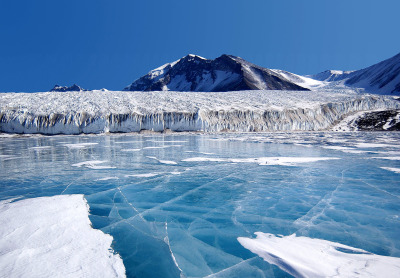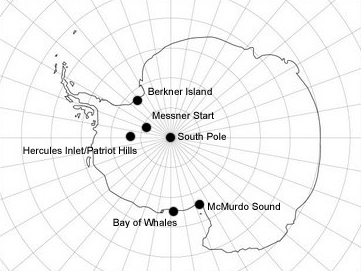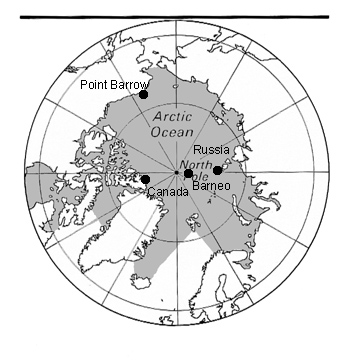Splitting hairs regarding Poles?
Are goals given in football when the ball hits the post and misses the net? Are tries given in rugby if the carrier touches down a foot short of the line? Are F1 drivers awarded a win even if overtaken on the last lap of a race? No, they're not.
No-one would argue with this because in a sporting arena, there has to be a set goal which you have to attain in order to win or score points. Whilst I'm usually very keen to point out that polar expeditions are not sport and have no governing body, no league table and no championship, there is an important parallel to be made.
It is November and this year, the same as years past, the expedition and adventure world is starting to talk about South Pole attempts this Antarctic season. The 'travelling season' lasts from October until February due to weather constraints and limited operation of logistics companies. A number of announcements have been emailed, linked and tweeted to me and as usual, there is the usual mix of serious professionals gearing up for big challenges, enthusiastic tourists getting ready for commercial adventures and jokers announcing outlandish plans.
 Every year the number does, on the surface, seem to ever increase as the feeling of 'I can do that too' spreads through the outdoor community. Amusingly this seems to have changed little as Winston Churchill exclaimed nearly a century ago that: 'These polar expeditions are becoming an industry.'
Every year the number does, on the surface, seem to ever increase as the feeling of 'I can do that too' spreads through the outdoor community. Amusingly this seems to have changed little as Winston Churchill exclaimed nearly a century ago that: 'These polar expeditions are becoming an industry.'
Dozens of expeditions will get press coverage, giving a false impression that it really is a case of travelling in a great convoy across the world's polar wastelands. Not so. In reality, only a tiny fraction of all announcements actually lead to an expedition setting foot on the ice. This is obviously a subjective matter but there have been precious few genuinely progressive expeditions in recent years - perhaps fewer than ten in as many years. Examples include the Gjeldnes/Larsen arctic traverse in 2000 and the Russian North Pole winter expedition of 2007/8.
Let's focus on an area I'm frequently quizzed about - how about where you ski from? It might seem like a fairly unimportant detail - surely it's just where you end up that matters? But that is not the case. If there is one point that I want to make in this entire post, it is this : use common-sense. If it seems too good to be true, it probably is.
So we come to the topic of start points. The main areas of conversation relate to the two Geographic Poles (the South in the middle of the Antarctic continent and the permanent icecap, the North in the centre of the temporary icecap covering the Arctic Ocean) but it can apply to any A-B or A-B-A expedition, anywhere in the world.
There are those who believe expeditions of wildly differing distances are comparable; that because the end point is the South Pole, a 65-mile last degree ski is "skiing to the South Pole" in the same way that a 900-mile Berkner Island to South Pole trip is. This makes no sense. The problem has arisen for one reason solely - the accessibility provided by aircraft. People can now choose their start point, a luxury that the pioneers did not enjoy. The whole matter of expeditions can therefore, if not kept in check, descend into academic technicalities rather than simple reason. The common start points of Hercules Inlet and the 'Messner' start for the South Pole are no better. They exist for one reason - their proximity to a convenient area to land large aircraft (Patriot Hills). If you want to travel overland to the South Pole on a full-length expedition, you must travel from the edge - the real edge. Hercules Inlet is the coast of the Antarctic in text books and nowhere else. It's where the rocky continent miles under the permanent ice dips below sea-level. If Hercules Inlet is the coast then you have to claim the Antarctic does not have a permanent icecap. You need to travel hundreds of miles further north to find the ocean. This is highly inconvenient for those who wish to take advantage of cheaper logistics from Patriot Hills, but is the truth. If you abandon this simple fact, you might as well fly to a mile from the Pole, ski for half an hour and claim a successful expedition. Here is a map to illustrate my points:

Berkner Island, McMurdo Sound and The Bay of Whales are examples of full-length expeditions to the South Pole - true expeditions.
The Messner Start, Hercules Inlet and Patriot Hills are examples of expeditions to the South Pole which are not full-length.
The significance of this is that since expeditions to the South Pole began in the early 20th century, barely a dozen expeditions have made the full journey, set against more than a hundred who have made partial trips after choosing their inland start point. True South Pole expeditions are therefore still the sole preserve of the dedicated, professional and skilled - encouraging news for all of us who are passionate about polar travel.
Exactly the same principle applies in the Arctic. The Greenland icecap is essentially an arctic equivalent of the Antarctic and so again, starting from the edge is vital. I am open about the fact that my 113-day Greenland expedition in 2008 began at sea-level, the edge, but at the half-way point descended off the icecap, onto the glacier and missed sea-level narrowly due to highly technical crevasses which would have required alpine climbing equipment to negotiate. The expedition therefore stood on its strengths, travelling 1374 miles fully without support, and does not claim a double Greenland traverse.
The Arctic Ocean and the North Pole are the scene of controversy both in history and in the present day. The early claims of Cook and Peary to have reached the Pole first are most likely fabrications and the shrinking icecap of the modern day presents challenges. The geography of the area means that the start points for North Pole expeditions are not where ocean meets permanent icecap, but rather where the floating sea-ice icecap meets the rest of the world - this is the Arctic Ocean 'edge'. The constantly mobile sea-ice presents a bit of a moving goal-post and so the recognised start point for a common-sense expedition is land. If in March, a common North Pole start time, the sea-ice does not fully reach land then you must start earlier when it is colder. The other option is to fly to where safe ice begins at your preferred start time. This is unsatisfactory since then it could be argued that you must fly further and further north to 'safe ice' - it would never end and the lengths of expeditions would forever decrease. You cannot make nature come to you - you must accept nature and its changes and work around it. The options are therefore the northern coasts of Russia, Canada, Greenland, Alaska, Spitsbergen and the islands lying offshore. These are concrete places from which comparisons can be made.
As at the opposite end of the Earth, there are 'last degree' shortcuts for commercial tourists who are looked after at a temporary Russian Barneo base on the sea-ice which is reconstructed each year (a mammoth undertaking and well worth some more reading). Most of these very short trips are again presented to the press as North Pole expeditions despite their proximity to rescue and ability to occur in the very best weather window, April, avoiding the misery of January to late March. Again, here is an illustration of the realities of North Pole expedition start points:
 Point Barrow (Alaska), Russian offshore islands and Canada (Ward Hunt Island) are examples of full-length expeditions to the North Pole.
Point Barrow (Alaska), Russian offshore islands and Canada (Ward Hunt Island) are examples of full-length expeditions to the North Pole.
Barneo Base at 89 Degrees North is an example of a partial expedition start point, mainly to stage tourist visits to the region.
The differences are extremely obvious in terms of sheer difficultly in physical and logistical terms. I hope these thoughts are of some use to those interested in the finer mechanisms of polar expedition planning and politics and may serve to put an end to some of the miseducation. As ever, the best advice for someone genuinely interested in getting involved in high-end polar expeditions is to endlessly practice your skills, listen to those who have experience and to read, research and read a bit more. There is no shortcut.